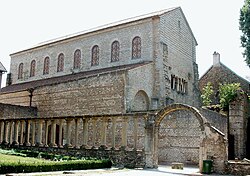.mw-parser-output .hidden-begin{box-sizing:border-box;width:100%;padding:5px;border:none;font-size:95%}.mw-parser-output .hidden-title{font-weight:bold;line-height:1.6;text-align:left}.mw-parser-output .hidden-content{text-align:left}@media all and (max-width:500px){.mw-parser-output .hidden-begin{width:auto!important;clear:none!important;float:none!important))You can help expand this article with text translated from
the corresponding article in French. (January 2012) Click [show] for important translation instructions.
View a machine-translated version of the French article.
Machine translation, like
DeepL or
Google Translate, is a useful starting point for translations, but translators must revise errors as necessary and confirm that the translation is accurate, rather than simply copy-pasting machine-translated text into the English Wikipedia.
Do not translate text that appears unreliable or low-quality. If possible, verify the text with references provided in the foreign-language article.
You must provide
copyright attribution in the
edit summary accompanying your translation by providing an
interlanguage link to the source of your translation. A model attribution edit summary is Content in this edit is translated from the existing French Wikipedia article at [[:fr:Église Saint-Pierre-aux-Nonnains]]; see its history for attribution.
You may also add the template ((Translated|fr|Église Saint-Pierre-aux-Nonnains)) to the
talk page.
For more guidance, see
Wikipedia:Translation.
| Basilica of Saint-Pierre-aux-Nonnains |
|---|
 |
 |
|
| Town or city | Metz |
|---|
| Country | France |
|---|
The basilica of Saint-Pierre-aux-Nonnains in Metz, France, is one of the oldest churches in Europe. The building began life in the 4th century when Metz was an important Gallo-Roman city.[1]
History
The building belonged to one of several thermae (public baths complexes) which existed in Metz in Roman times.[2] Some sources describe it as having been a gymnasium. In the 7th century, the structure was converted into a church, becoming the chapel of a Benedictine nunnery. A new nave was constructed in the 11th century with further interior renovations.
In the 16th century Metz was besieged by the troops of Charles V and later was converted into an important garrison town by the French. The building became a warehouse, and remained so after being declared a historical monument in 1909. In the 1970s it was restored and opened for concerts and exhibitions.[3][4][5][6]

